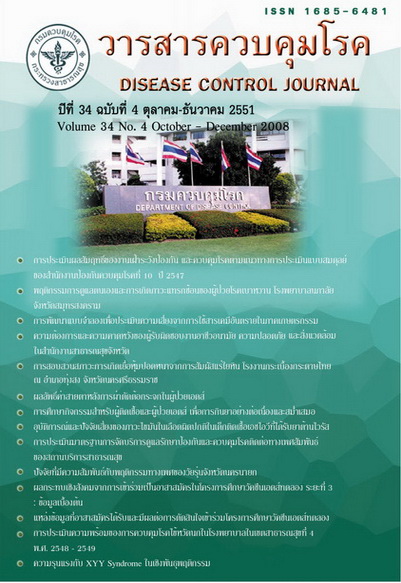Chemical Risk Assessment Simulation Program in Agricultural Sector
Keywords:
Risk Assessment, Software Program, Chemical in Agricultural Sector, StakeholderAbstract
Chemical Risk Assessment Simulation Program Development in Agricultural Sector This study was experimental model designed to develop chemical risk assessment simulation program in agricultural sector through the process of participatory risk assessment . The aim of this study not only to get the most effective tool to evaluate the chemical risk assessment in agricultural sector but also to motivate the farmer and community people to pay more attention on the danger of chemical uses in agriculture activities . This study had been divided into two parts, : Chemical Risk Assessment Simulation Program Development ,Literature review and stakeholder group had been participated in the meeting forums for sharing their experience and setting the information items dealing with the variables concerned in hazard identification and exposure opportunity of people in the community for serving the basic formula of risk level equal to hazard multiply by exposure opportunity. Monte Carlo Simulation Model was used to analyze the distribution pattern of hazard and exposure score. The result showed that 31 data items had been set up and divided in 3 parts; general information 8 items, hazard identification 8 items , health status 8 items and environmental management 7 items. The score rating was implemented under the score ranging in each item 0 - 10 scores by individual rating found that hazard identification value ranging from 4 - 24 , exposure opportunity value ranging from 55 -95 effect to the risk level which divided in 5 levels that is safety level lower than 220, risk level 221-585, unsafe level 586-1050, danger level 1051-1615 and severe danger level 1616-2280. Then the quality of measurement had been analyzed by percentage , arithmetic mean , standard deviation , t - test and fix the significant at P=0.05 which found that r =/> .90 , t >2 , P< 0.05. It means that the score ranging design accepted. All of these data had been computerized into software program which can be presented in statistical data and geological information system. This software computer had been designed for more convenient to users for adjusting as they required. In part 2: This software had been experimented for 3-6 months in 6 Tambon Administration Office in Sakao province. This trial proved that experimental group accepted this software program in average 85 % of local authority leaders , farmers and data collection officers. However, it needs to be confirmed by scientific evaluation by standard equipment for chemical hazard concentration and chemical exposure of people in the community to strengthening the strong believe of this software program benefit.
Downloads
References
2. พงศ์เทพ วิวรรธนะเดช และคณะ. โครงการพัฒนาแบบจำลองทางคณิตศาสตร์เพื่อประเมินระดับความปลอดภัยของประชาชนต่อการได้รับสารอินทรีย์ระเหยในบรรยากาศ. ภาควิชาเวชศาสตร์ชุมชน คณะแพทย์ศาสตร์ มหาวิทยาลัยเชียงใหม่ ; 2548
3. เกรียง กิจบำรุงรัตน์. การประยุกต์ของการวิเคราะห์การถดถอยปัวซองสำหรับระบบแถวคอยของความต้องการสำหรับการรักษาพยาบาลและการบริการสาธารณสุข. วิทยานิพนธ์ปริญญาเอก , มหาวิทยาลัยมหิดล ; 2550
4. พันธุ์ทิพย์ รามสูต. การวิจัยปฏิบัติการแบบมีส่วนร่วม. สถาบันพัฒนาการสาธารณสุขอาเซียน นครปฐม มหาวิทยาลัยมหิดล ; 2540
5. สมเกียรติ ศิริรัตนพฤกษ์และคณะ. โครงการศึกษาความต้องการและทบทวนดัชนีวัดสิ่งแวดล้อมและอาชีวอนามัยในประเทศไทย.โครงการทุนอุดหนุนจากสถาบันวิจัยระบบสาธารณสุขและสำนักงานกองทุนสนับสนุนการสร้างเสริมสุขภาพ; 2549
6. Wilson AR. Environmental risk management policy. In : Environmental risk : identification and management. Chelsea : Lewis Publishers Inc., 1991: 77-103
7. Rodricks JV. Calculated risks : understanding the toxicity and human health risks of chemicals in our environment. New York: Cambridge University Press, 1994: 158-179
8. Hallenbeck WH. Quantitative risk assessment for environmental and occupational health. Chelsea: Lewis Publishers, 1993: 63-126
Downloads
Published
How to Cite
Issue
Section
License
Articles published in the Disease Control Journal are considered as academic work, research or analysis of the personal opinion of the authors, not the opinion of the Thailand Department of Disease Control or editorial team. The authors must be responsible for their articles.






